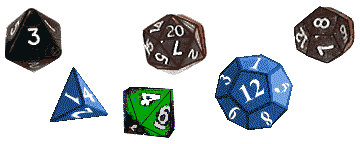|

Ideas that Lead to Probability
Abstract
The activity and two discussions that make up this lesson introduce ideas that
are the basis of probability theory. By using everyday experiences and intuitive
understanding, this lesson gives students a gradual introduction to probability.
Objectives
Upon completion of this lesson, students will:
- have been introduced to the concept of probability
- have worked with random number generators
- have learned what it means for a game to be fair
Standards
The activities and discussions in this lesson address the following
NCTM standards:
Data Analysis and Probability
Understand and apply basic concepts of probability
- understand and use appropriate terminology to describe complementary and mutually exclusive events
- use proportionality and a basic understanding of probability to make and test conjectures about the results of experiments and simulations
- compute probabilities for simple compound events, using such methods as organized lists, tree diagrams, and area models
Links to other standards.
Student Prerequisites
- Arithmetic: Students must be able to:
- use addition when working with dice
- Technological: Students must be able to:
- perform basic mouse manipulations such as point,
click and drag
- use a browser such as Netscape for experimenting with
the activities
Teacher Preparation
Students will need:
- Access to a browser
- Copies of the supplemental materials:
The following objects or their pictures may be used in activities or to illustrate
the discussions.
- 1. Dice with various numbers of sides.

- 2. Spinners. 3. Bag of lotto pieces with numbers. 4. Lottery machine.



Key Terms
This lesson introduces students to the following terms through the included discussions:
Lesson Outline
- Focus and Review
Remind students what has been learned in previous lessons that will be pertinent to this lesson and/or
have them begin to think about the words and ideas of this lesson:
- If I bet you that we could play a game and that I could win every time, would you believe me?
- This game is a racing game in which we take turns rolling a six sided die
and advancing on the numbers that we each are assigned. I bet you I can assign
us an equal quantity of numbers that we move on and no matter how many times we play I
will always win.
- Then tell them that the numbers that you assign yourself are 1, 2, 3, 4, 5, and 6,
while the numbers you assign the person who takes you up on your bet are 7, 8, 9, 10, 11, and 12.
(If you are only playing with one die then it is impossible to roll anything higher than a 6 so
the person assigned 6 -12 will never move.)
- Who thinks this game is fair?
- Objectives
Let the students know what it is they will be doing and learning today. Say something like
this:
- Today, class, we are going to begin learning about random number generators and probability.
- We are going to use the computers to learn about random number generators and probability,
but please do not turn your computers on until I ask you to. I want to show you a little about
this activity first.
- Teacher Input
- Guided Practice
- Have students can use The Racing Game
with One Die as an example of a game that is either fair or not. Make sure to
adjust the settings on the game so that the race is only one step long. Since the
game is used for illustration only, it can be played by each student individually,
by groups of students, or by one person who broadcasts it for everybody else to see.
- Have them discuss different ways that they can make the game fair and not fair.
- Independent Practice
- Now have the students play
The Racing Game with One Die. Each group of students can come up with
their own way of randomly choosing which players move on which rolls.
- Also have them adjust the number of steps in the race and observe
the affect it has on the probability that one player will win over the other.
- You might also challenge the students to find the combination of race length
and numbers needed to cause one player to have a specific probability of winning.
- Closure
- You may wish to bring the class back together for a discussion of the findings.
Once the students have been allowed to share what they found, summarize the results of
the lesson.
Alternate Outlines
This lesson can be rearranged in several ways.
Suggested Follow-Up
After these discussions and activities, the students will have
the beginnings of an understanding of probability, randomness and fair choice.
The next lesson, Unexpected Answers,
continues the initial exploration of probability and presents some unusual examples of
games that require close examination to determine if they are fair.
|




